key Lexus GX470 2007 Instrument cluster / LEXUS 2007 GX470 (OM60C64U) User Guide
[x] Cancel search | Manufacturer: LEXUS, Model Year: 2007, Model line: GX470, Model: Lexus GX470 2007Pages: 436, PDF Size: 11.52 MB
Page 61 of 436
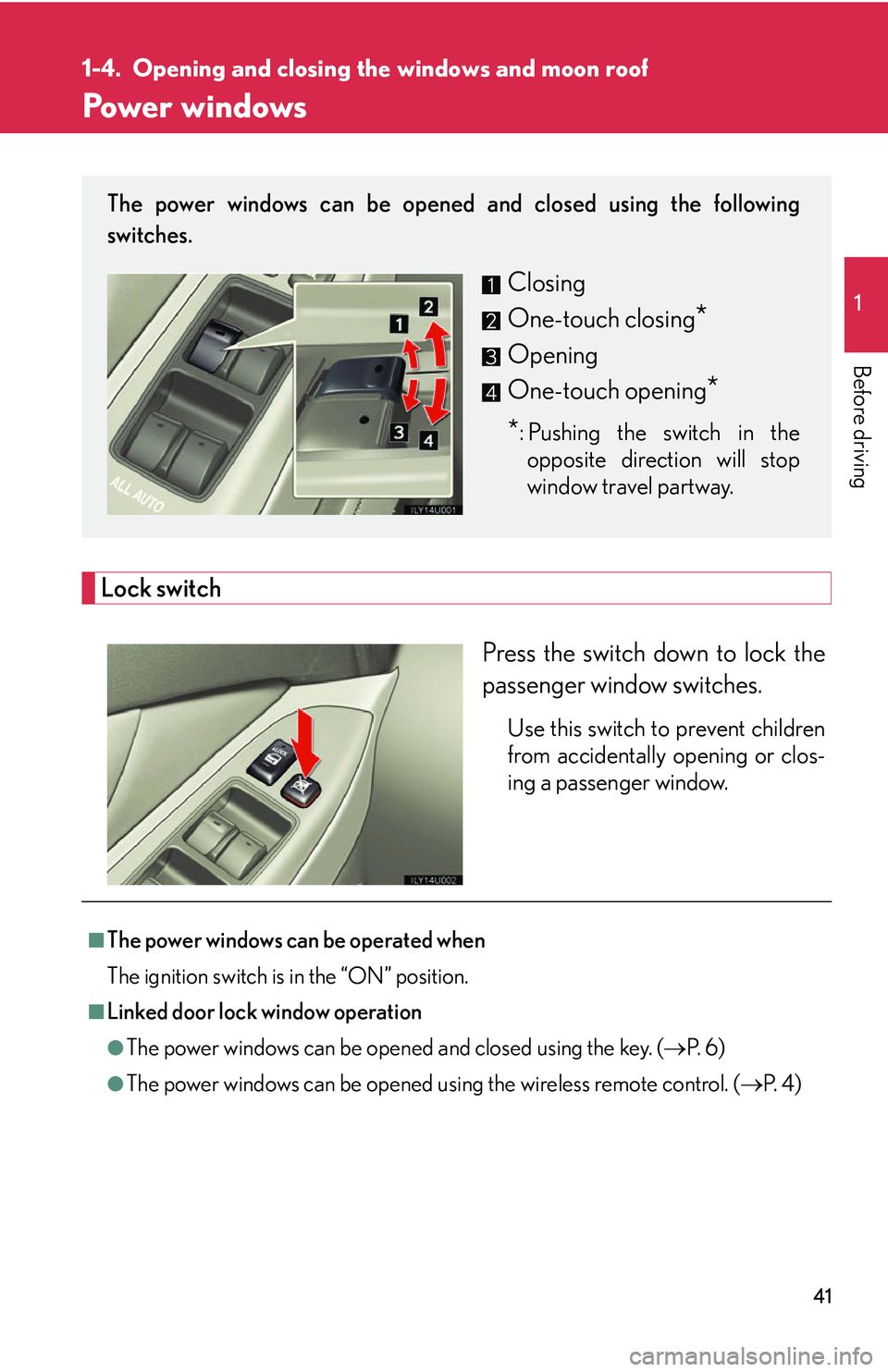
41
1
Before driving
1-4. Opening and closing the windows and moon roof
Power windows
Lock switch
Press the switch down to lock the
passenger window switches.
Use this switch to prevent children
from accidentally opening or clos-
ing a passenger window.
The power windows can be opened and closed using the following
switches.
Closing
One-touch closing
*
Opening
One-touch opening
*
*: Pushing the switch in theopposite direction will stop
window travel partway.
■The power windows can be operated when
The ignition switch is in the “ON” position.
■Linked door lock window operation
●The power windows can be opened and closed using the key. ( P. 6 )
●The power windows can be opened using the wireless remote control. ( P. 4 )
Page 64 of 436
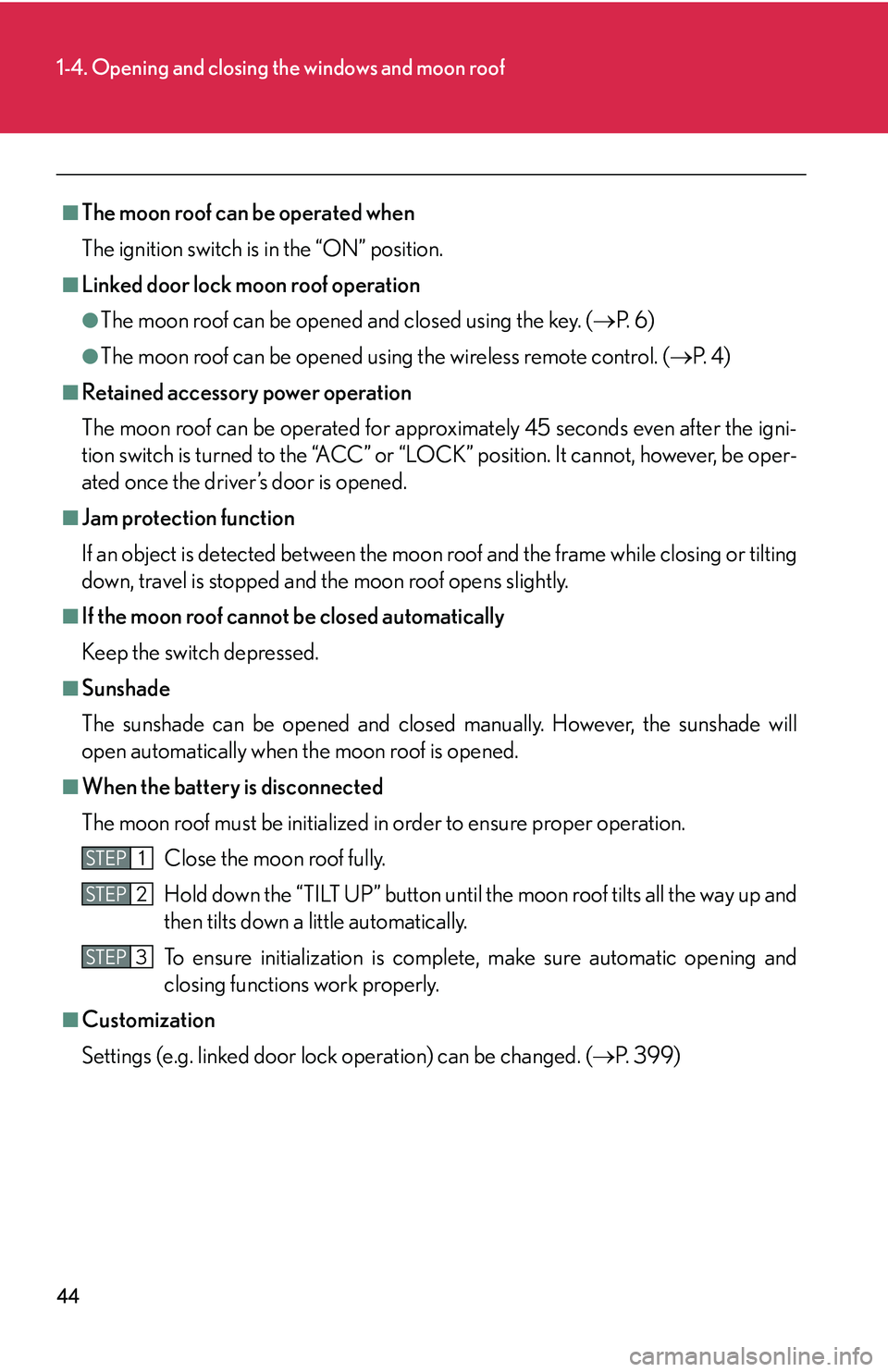
44
1-4. Opening and closing the windows and moon roof
■The moon roof can be operated when
The ignition switch is in the “ON” position.
■Linked door lock moon roof operation
●The moon roof can be opened and closed using the key. ( P. 6 )
●The moon roof can be opened using the wireless remote control. ( P. 4 )
■Retained accessory power operation
The moon roof can be operated for approx imately 45 seconds even after the igni-
tion switch is turned to the “ACC” or “LOC K” position. It cannot, however, be oper-
ated once the driver’s door is opened.
■Jam protection function
If an object is detected between the moon roof and the frame while closing or tilting
down, travel is stopped and the moon roof opens slightly.
■If the moon roof cannot be closed automatically
Keep the switch depressed.
■Sunshade
The sunshade can be opened and closed manually. However, the sunshade will
open automatically when the moon roof is opened.
■When the battery is disconnected
The moon roof must be initialized in order to ensure proper operation.
Close the moon roof fully.
Hold down the “TILT UP” button until th e moon roof tilts all the way up and
then tilts down a little automatically.
To ensure initialization is complete, make sure automatic opening and
closing functions work properly.
■Customization
Settings (e.g. linked door lock operation) can be changed. ( P. 3 9 9 )
STEP1
STEP2
STEP3
Page 69 of 436

49
1
Before driving
1-6. Theft deterrent system
Engine immobilizer system
■Conditions that may cause the system to malfunction
●If the grip portion of the key is in contact with a metallic object.
●If the key is in close proximity to or touching a key to the security system (key
with a built-in transponder chip) of another vehicle.
■Certifications for the engine immobilizer system For vehicles sold in the U.S.A.
This device complies with Part 15 of the FCC Rules. Operation is subject to the fol-
lowing two conditions: (1) This device may not cause harmful interference, and (2)
this device must accept any interference received, including interference that may
cause undesired operation.
For vehicles sold in Canada
Operation is subject to the following two conditions: (1) this device may not cause
interference, and (2) this device must a ccept any interference, including interfer-
ence that may cause undesired operation of the device.
The vehicle's keys have built-in transponder chips that prevent the engine
from starting if the key has not been previously registered in the vehicle's
on-board computer.
The indicator light flashes after
the ignition switch has been
turned to the “LOCK” position
to indicate that the system is
operating.
FCC ID: MOZRI-20BTY
Page 71 of 436
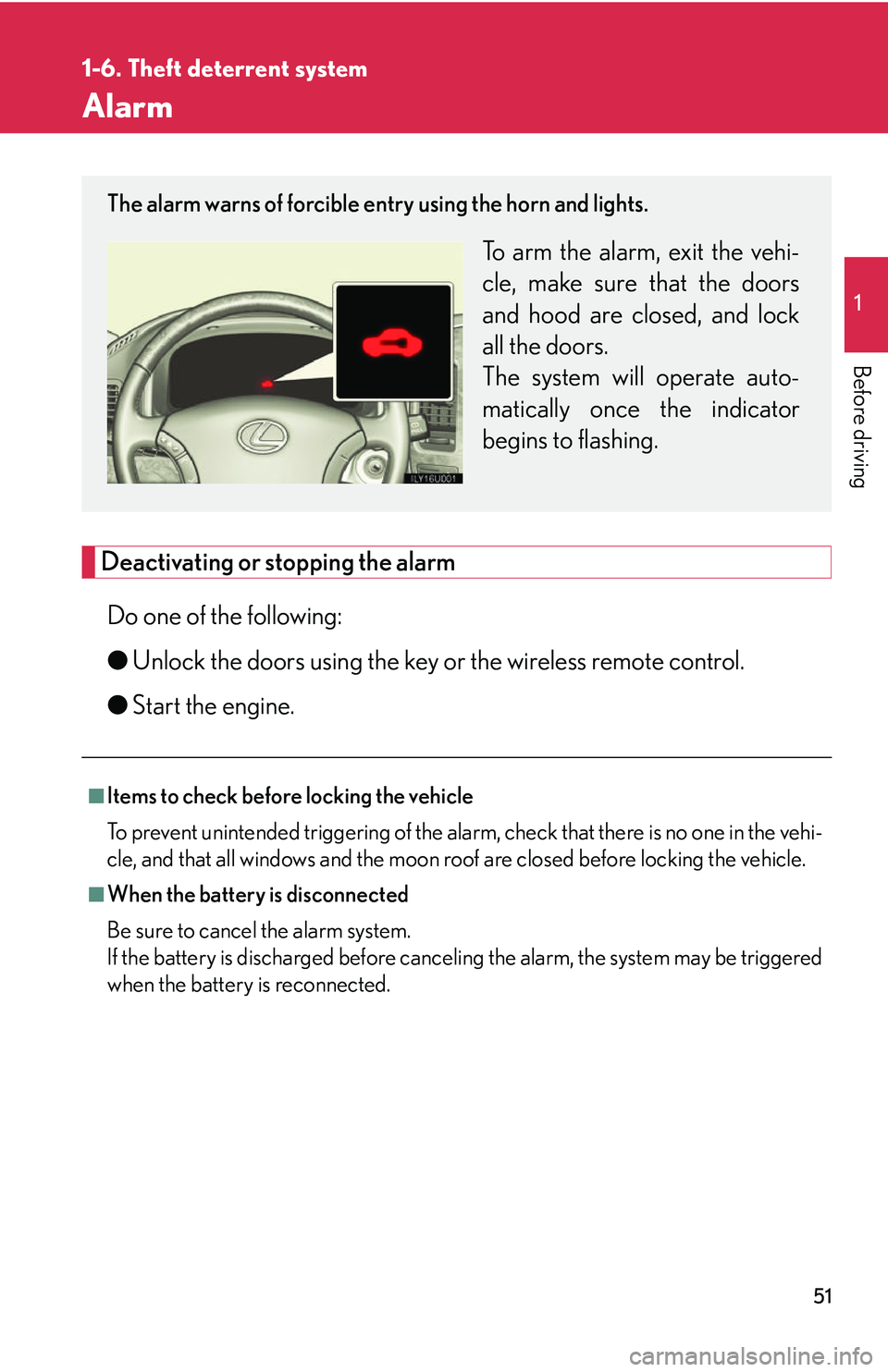
51
1
1-6. Theft deterrent system
Before driving
Alarm
Deactivating or stopping the alarmDo one of the following:
● Unlock the doors using the key or the wireless remote control.
● Start the engine.
■Items to check before locking the vehicle
To prevent unintended triggering of the alar m, check that there is no one in the vehi-
cle, and that all windows and the moon roof are closed before locking the vehicle.
■When the battery is disconnected
Be sure to cancel the alarm system.
If the battery is discharged before cancel ing the alarm, the system may be triggered
when the battery is reconnected.
The alarm warns of forcible entry using the horn and lights.
To arm the alarm, exit the vehi-
cle, make sure that the doors
and hood are closed, and lock
all the doors.
The system will operate auto-
matically once the indicator
begins to flashing.
Page 108 of 436
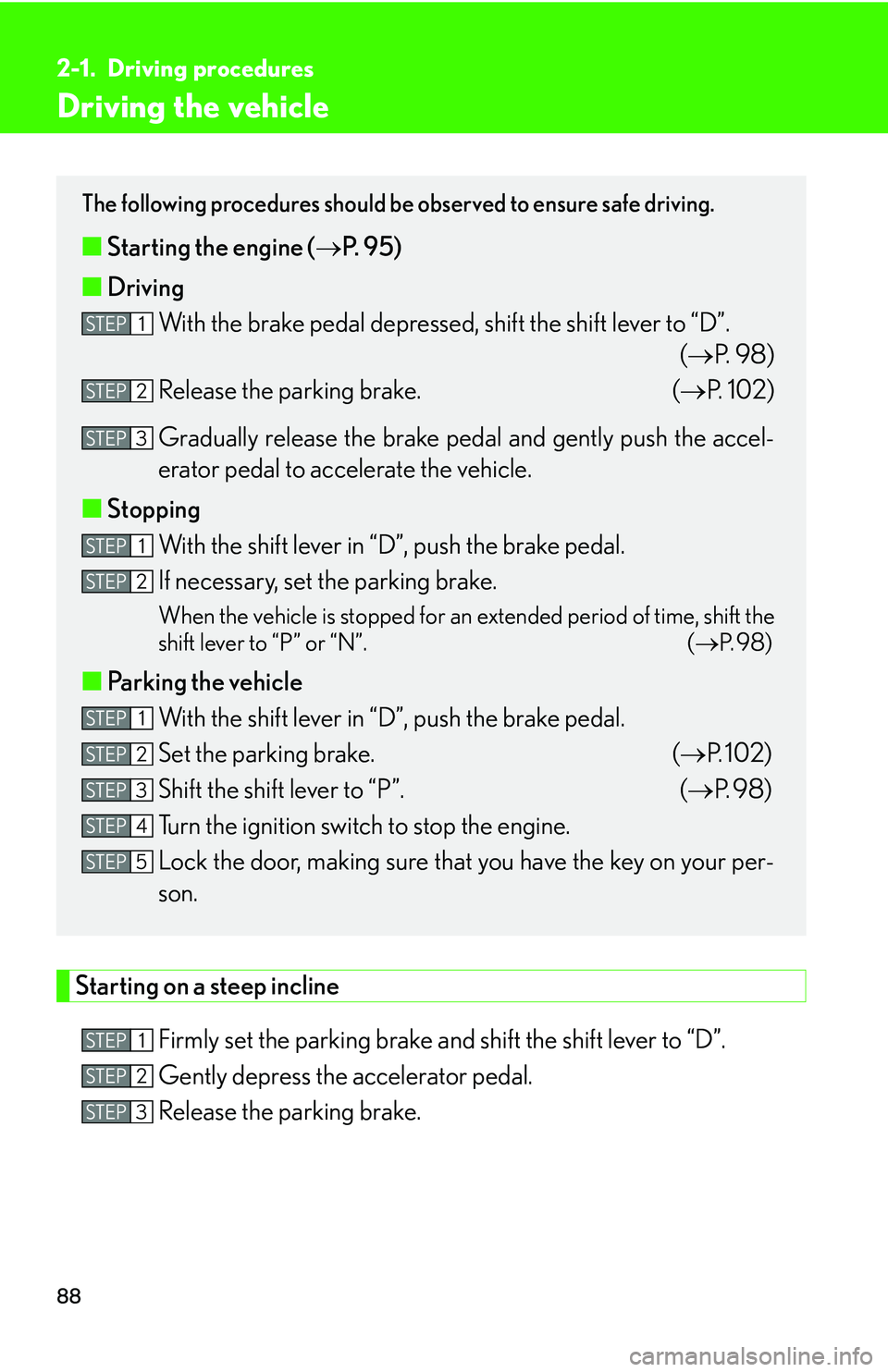
88
2-1. Driving procedures
Driving the vehicle
Starting on a steep inclineFirmly set the parking brake and shift the shift lever to “D”.
Gently depress the accelerator pedal.
Release the parking brake.
The following procedures should be observed to ensure safe driving.
■ Starting the engine ( P. 9 5 )
■ Driving
With the brake pedal depressed, shift the shift lever to “D”. (P. 9 8 )
Release the parking brake. ( P. 1 0 2 )
Gradually release the brake peda l and gently push the accel-
erator pedal to accelerate the vehicle.
■ Stopping
With the shift lever in “D”, push the brake pedal.
If necessary, set the parking brake.
When the vehicle is stopped for an extended period of time, shift the
shift lever to “P” or “N”. ( P. 9 8 )
■Parking the vehicle
With the shift lever in “D”, push the brake pedal.
Set the parking brake. ( P. 1 0 2 )
Shift the shift lever to “P”. ( P. 9 8 )
Turn the ignition switch to stop the engine.
Lock the door, making sure that you have the key on your per-
son.
STEP1
STEP2
STEP3
STEP1
STEP2
STEP1
STEP2
STEP3
STEP4
STEP5
STEP1
STEP2
STEP3
Page 115 of 436
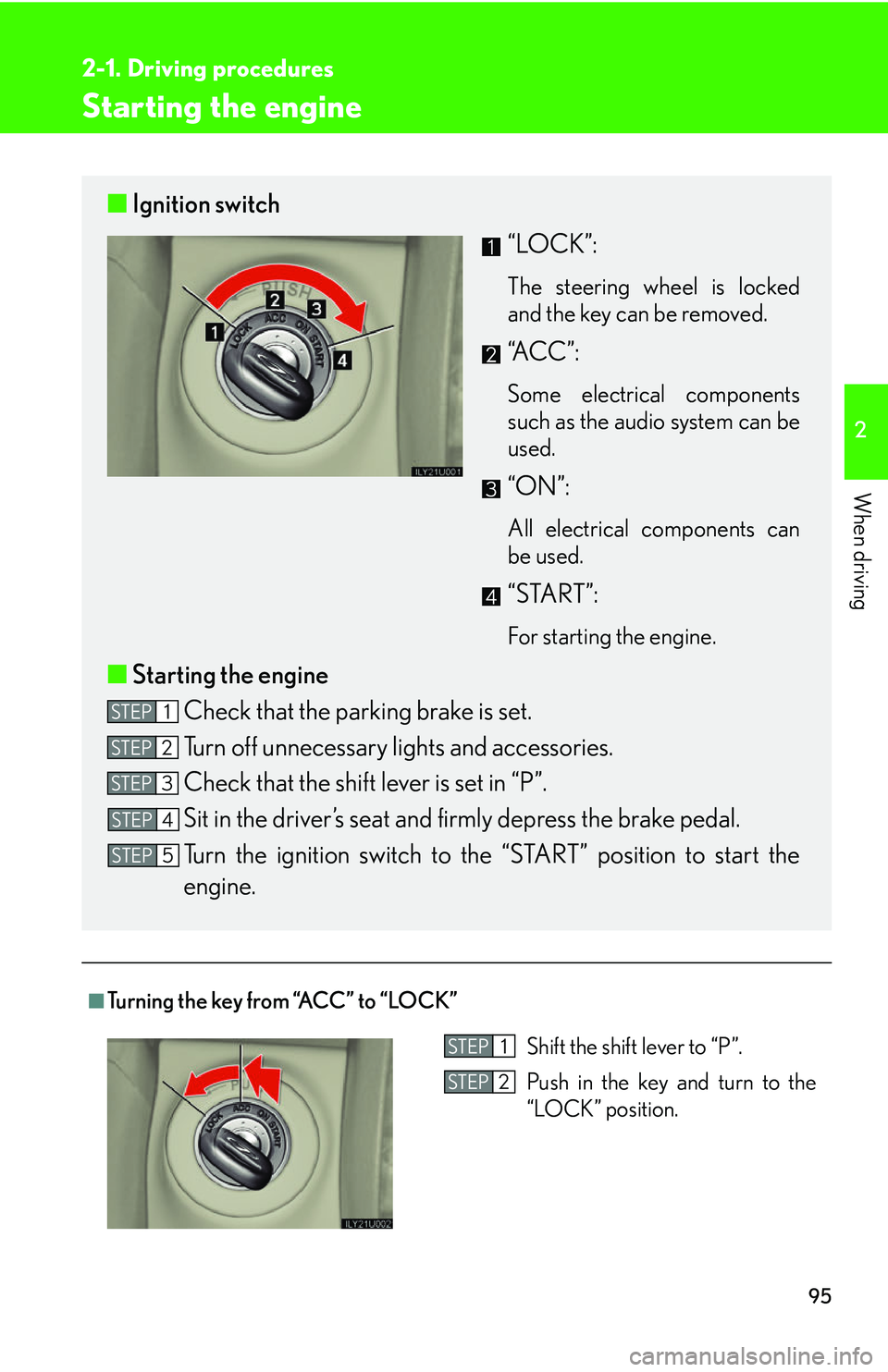
95
2-1. Driving procedures
2
When driving
Starting the engine
■Turning the key from “ACC” to “LOCK”
■Ignition switch
“LOCK”:
The steering wheel is locked
and the key can be removed.
“A C C ” :
Some electrical components
such as the audio system can be
used.
“ON”:
All electrical components can
be used.
“START”:
For starting the engine.
■Starting the engine
Check that the parking brake is set.
Turn off unnecessary lights and accessories.
Check that the shift lever is set in “P”.
Sit in the driver’s seat and firmly depress the brake pedal.
Turn the ignition switch to the “START” position to start the
engine.
STEP1
STEP2
STEP3
STEP4
STEP5
Shift the shift lever to “P”.
Push in the key and turn to the
“LOCK” position.STEP1
STEP2
Page 116 of 436

96
2-1. Driving procedures
■Steering lock release
■Starting the engine using the flat keyPut the key case away when the security indicator light goes out. This
means the engine immobilizer system has turned off.
Start the engine within 60 seconds after the security indicator light goes
off.
■Leak detection pump
Several hours after the engine is turned off, you may hear a sound coming from
underneath the luggage compartment for several minutes. This is normal operation
and does not indicate a malfunction.
When starting the engine, the ignition switch
may seem stuck in the “LOCK” position. To
free it, turn the ignition key while turning the
steering wheel slightly in either direction.
Remove the flat key from its case. Insert the
key into the ignition switch.STEP1
Bring the key case close to the ignition switch
within 10 seconds as indicated by an arrow.STEP2
STEP3
STEP4
Page 117 of 436
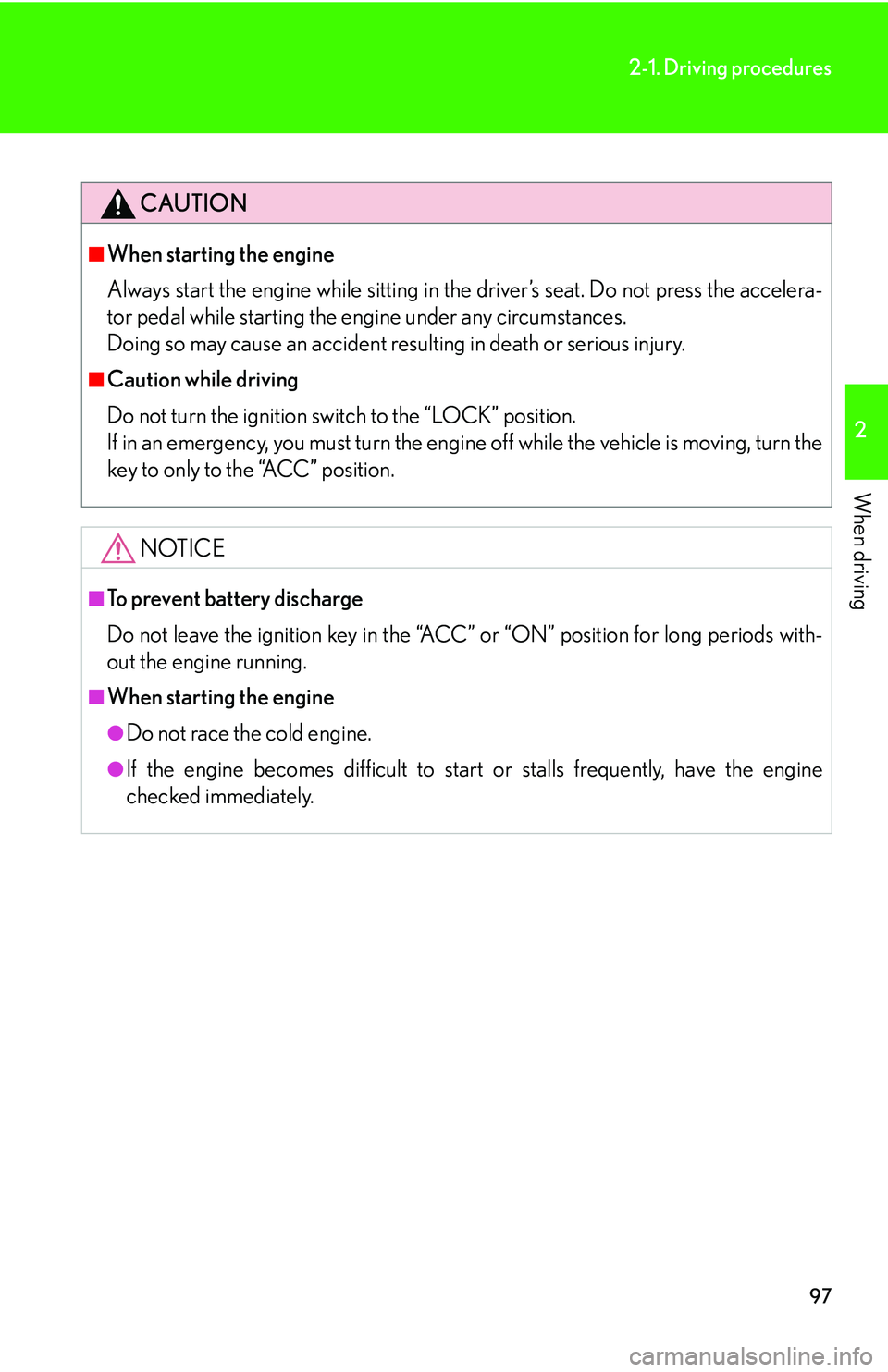
97
2-1. Driving procedures
2
When driving
CAUTION
■When starting the engine
Always start the engine while sitting in the driver’s seat. Do not press the accelera-
tor pedal while starting the engine under any circumstances.
Doing so may cause an accident resu lting in death or serious injury.
■Caution while driving
Do not turn the ignition switch to the “LOCK” position.
If in an emergency, you must turn the engi ne off while the vehicle is moving, turn the
key to only to the “ACC” position.
NOTICE
■To prevent battery discharge
Do not leave the ignition key in the “ACC” or “ON” position for long periods with-
out the engine running.
■When starting the engine
●Do not race the cold engine.
●If the engine becomes difficult to start or stalls frequently, have the engine
checked immediately.
Page 132 of 436
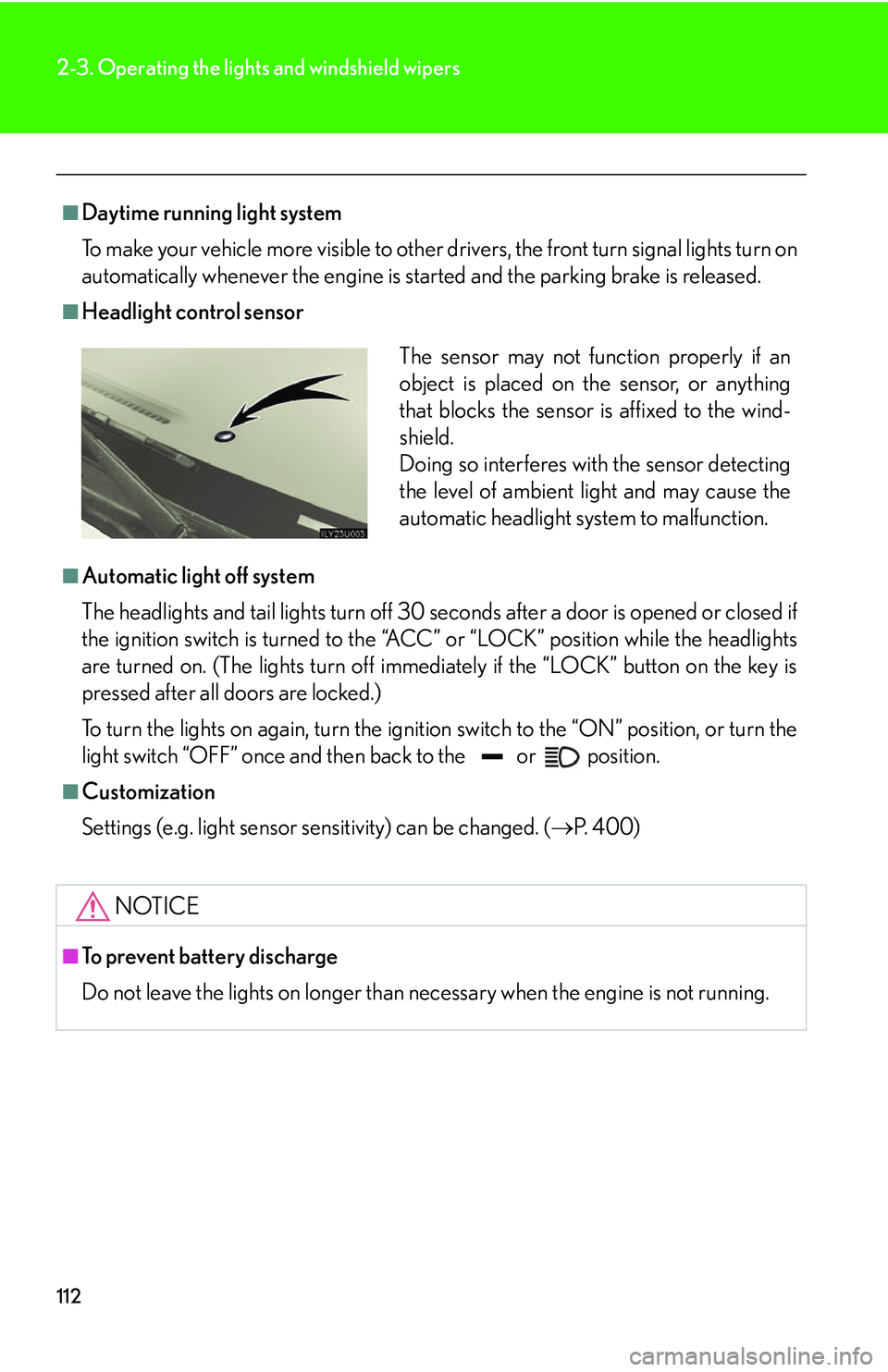
112
2-3. Operating the lights and windshield wipers
■Daytime running light system
To make your vehicle more visible to other drivers, the front turn signal lights turn on
automatically whenever the engine is started and the parking brake is released.
■Headlight control sensor
■Automatic light off system
The headlights and tail lights turn off 30 seconds after a door is opened or closed if
the ignition switch is turned to the “ACC ” or “LOCK” position while the headlights
are turned on. (The lights turn off immedi ately if the “LOCK” button on the key is
pressed after all doors are locked.)
To turn the lights on again, turn the igniti on switch to the “ON” position, or turn the
light switch “OFF” once and th en back to the or position.
■Customization
Settings (e.g. light sensor sensitivity) can be changed. ( P. 400)
NOTICE
■To prevent battery discharge
Do not leave the lights on longer than necessary when the engine is not running.
The sensor may not function properly if an
object is placed on the sensor, or anything
that blocks the sensor is affixed to the wind-
shield.
Doing so interferes with the sensor detecting
the level of ambient light and may cause the
automatic headlight system to malfunction.
Page 151 of 436

131
2-4. Using other driving systems
2
When driving
■Operating tips
The system will operate when the shift lever is in a position other than “P”, however
to make effective use of the system it is recommended that the shift lever be shifted
to “2” or “L”.
■If the four wheel drive control lever is in “H”
The system will not operate.
■If the brake system overheats
The system will cease operation and a bu zzer will sound to alert the driver.
Stop the vehicle in a safe place. (There is no problem with continuing normal driv-
ing.)
■System malfunction
●The “DAC” indicator does not come on when the ignition key is turned to the
“ON” position.
●The “DAC” indicator does not come on when the “DAC” switch is pressed.
In the above cases have your vehicle checked by your Lexus dealer.
CAUTION
■The system may not operate on the following surfaces, which may lead to an acci-
dent causing death or serious injury.
●Slippery surfaces such as wet or muddy roads
●Icy surfaces
●Unpaved roads